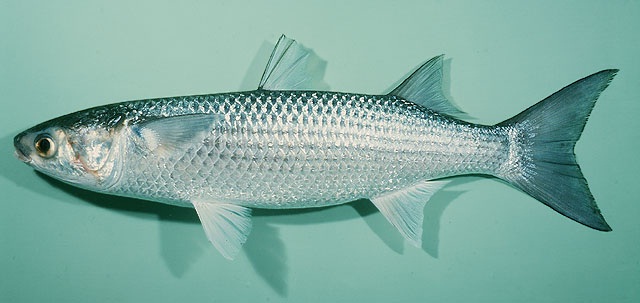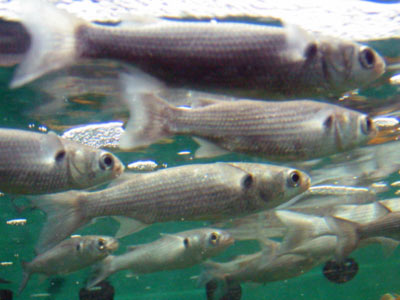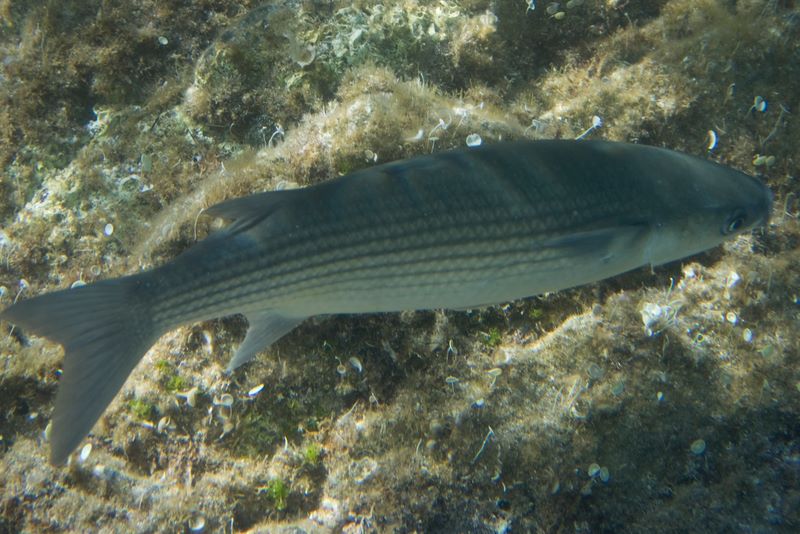
Mugil cephalus
FAMILY
Mugilidae
TAXONOMY
Mugil cephalus Linnaeus, 1758, European seas. It has been suggested
that several species, initially distinguished by slight differences
in morphological features, fin ray counts, dentition,
and fin coloration, are synonymous with Mugil cephalus. Some
authors have indicated that the concept of Mugil cephalus as a
widespread, polymorphic species may be incorrect. According
to comparative analyses of the morphometrics, isozymes, and
mitochondrial DNA of populations of Mugil cephalus from
around the world, however, the variation between populations
is not large enough to indicate definitively that they are differentiated
species.
OTHER COMMON NAMES
English: Striped mullet, black mullet; French: Mulet cabot;
Spanish: Lisa pardete.
PHYSICAL CHARACTERISTICS
Commonly reaches 13.8 in (35 cm) in total length but may
reach 47.2 in (120 cm) in standard length. Adipose tissue covers
most of the eye. There are several rows of very small unicuspid
and bicuspid teeth on the edges of the lips. Anal fin has
three spines and eight soft rays in adults. There are 36–44
scales in a longitudinal series along the flanks. Body is olivegreen
dorsally and silvery on the flanks and abdomen, with
about seven longitudinal dark stripes along the flanks. The
pelvic fin, anal fin, and lower lobe of the caudal fin are yellowish
in some populations.
DISTRIBUTION
Worldwide in tropical, subtropical, and warm temperate waters
from 42° S latitude to almost 51° N latitude; less abundant in
the tropics.
HABITAT
Tolerant of salinity levels from zero to 81 parts per thousand
(freshwater to hypersaline) and temperatures from 41°F (5°C)
to 98.6°F (37°C). Inhabits inshore marine waters, estuaries, lagoons,
and rivers, usually in shallow waters, and rarely moving
deeper than 656 ft (200 m). Adults may move far upriver.
BEHAVIOR
The adults form schools and sometimes jump.
FEEDING ECOLOGY AND DIET
Larvae and juveniles feed on plankton. Adults feed on particulate
organic material, algae, and invertebrates. Fish may gulp
and filter sediment, browse over submerged surfaces, or feed at
the surface.
REPRODUCTIVE BIOLOGY
Adult fish move offshore in shoals to spawn, usually at night,
before returning to inshore brackish waters and freshwaters.
Fry and juveniles remain in sheltered bays, lagoons, and estuaries
until they are sexually mature.
CONSERVATION STATUS
Not threatened.
SIGNIFICANCE TO HUMANS
Major commerical and subsistence fisheries in many parts of the
world. Food and Agriculture Organization (FAO) of the United
Nations statistics give the global commercial capture of flathead
mullets for 2000 as 29,335 metric tons (18% and 19% coming
from Mexico and Venezuela, respectively). Global aquaculture of
flathead mullets in 2000 was 89,078 metric tons (90% coming
from Egypt), with a value of almost $312.3 million dollars.
Photo Gallery of - Flathead mullet





 Animalia Life
Animalia Life